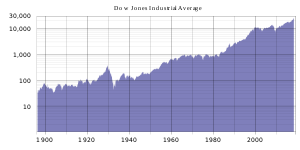 Historical logarithmic graph of the DJIA from 1896 to 2018 | |
| Foundation | February 16, 1885 (as DJA)[1] May 26, 1896 (as DJIA)[2] |
|---|---|
| Operator | S&P Dow Jones Indices |
| Exchanges | |
| Trading symbol |
|
| Constituents | 30 |
| Type | Large cap |
| Market cap | US$12.0 trillion (as of December 29, 2023[update])[3] |
| Weighting method | Price-weighted index |
| Website | www |
The Dow Jones Industrial Average (DJIA), Dow Jones, or simply the Dow (/ˈdaʊ/), is a stock market index of 30 prominent companies listed on stock exchanges in the United States.
The DJIA is one of the oldest and most commonly followed equity indexes. Many professionals[who?] consider it to be an inadequate representation of the overall U.S. stock market compared to a broader market index such as the S&P 500. The DJIA includes only 30 large companies. It is price-weighted, unlike other common indexes such as the Nasdaq Composite or S&P 500, which use market capitalization.[4][5][6][7]
The value of the index can also be calculated as the sum of the stock prices of the companies included in the index, divided by a factor, which is approximately 0.152 as of April 2024[update]. The factor is changed whenever a constituent company undergoes a stock split so that the value of the index is unaffected by the stock split.
First calculated on May 26, 1896,[2] the index is the second-oldest among U.S. market indices, after the Dow Jones Transportation Average. It was created by Charles Dow, co-founder of both The Wall Street Journal and Dow Jones & Company, and named after him and his business associate, statistician Edward Jones.
The index is maintained by S&P Dow Jones Indices, an entity majority-owned by S&P Global. Its components are selected by a committee. The ten components with the largest dividend yields are commonly referred to as the Dogs of the Dow. As with all stock prices, the prices of the constituent stocks and consequently the value of the index itself are affected by the performance of the respective companies as well as macroeconomic factors.

- ^ "Dow Record Book Adds Another First". Philly.com. February 24, 1995. Archived from the original on October 4, 2013.
- ^ a b Judge, Ben (May 26, 2015). "26 May 1896: Charles Dow launches the Dow Jones Industrial Average". MoneyWeek. Archived from the original on October 6, 2019. Retrieved October 6, 2019.
- ^ "Dow Jones Industrial Average® Fact Sheet" (PDF). S&P Global.
- ^ "Standard & Poor's 500 Index – S&P 500". Investopedia. Archived from the original on June 14, 2012. Retrieved September 15, 2019.
- ^ Deporre, James (September 7, 2018). "Ignore the Misleading Dow Jones Industrial Average". TheStreet.com. Archived from the original on August 12, 2019. Retrieved August 12, 2019.
- ^ Floyd, David (June 25, 2019). "Discover What Makes the Dow Jones Industrial Average Stupid". Investopedia. Archived from the original on August 12, 2019. Retrieved August 12, 2019.
- ^ Dzombak, Dan (April 18, 2014). "Why the Dow Jones Industrial Average Is Useless". The Motley Fool. Archived from the original on August 12, 2019. Retrieved August 12, 2019.